FAQs
🔰 Getting Started – Choosing Your Perfect Knife
Which knife line is right for me? (see comparison here)
KYU (Sakai Kyuba) is your perfect entry point to premium Japanese knives. Crafted in the historic Sakai region near Osaka, these knives feature AUS10 steel at HRC 62 with a stunning 46-layer Damascus construction. The hammered finish isn’t just beautiful – it helps food release from the blade. Prices range from £250-270 for individual knives or £650 for a complete set. This line is ideal if you’re beginning your journey with Japanese steel and want something that feels special without being intimidating.
KATA (Seki Kyuba) represents elevated performance with a minimalist aesthetic. Made in Seki, Gifu Prefecture – a legendary sword-making region since the 13th century – these knives use VG10 steel in a clean 3-layer construction. The visible core steel and hammered finish give a modern, functional look. At HRC 60-62, they offer exceptional sharpness and edge retention. Individual knives cost £250-295, with sets at £710. Choose KATA if you appreciate clean design and want a knife that’s straightforward to maintain whilst delivering professional-level results.
RYU (Seki Kyuba) is for those who view cooking as an art form. The name means “style” or “flow” in Japanese, and the full Damascus pattern across the blade embodies this philosophy. With VG10 core steel wrapped in 33 layers, these knives glide through ingredients with remarkable ease. At HRC 62, they maintain their edge beautifully. Priced at £250-295 individually or £720 for a set, RYU appeals to cooking enthusiasts who want their tools to be as beautiful as the dishes they create.
NIJI (Seki Kyuba) – meaning “rainbow” – is truly unique. Each knife features a 37-layer construction incorporating stainless steel, brass, and copper, creating mesmerising patterns that catch light differently from every angle. The 12Cr18MoV core steel at HRC 62-63 offers excellent performance, whilst the multi-metal layering makes each knife a one-of-a-kind work of art. Prices range from £270-330. This line is perfect for collectors, art lovers, and anyone who wants their knives to be conversation pieces as well as serious kitchen tools.
SHIN (Seki Kyuba) – meaning “truth” or “essence” – represents the pinnacle of our collection. These knives use SG2/R2 powder steel, one of the finest blade steels available, at HRC 63-64. The 31-layer Damascus cladding creates intricate patterns, and edge retention is superior to anything else we offer. Individual knives range from £320-425. If you’re a professional chef, a serious home cook, or simply someone who wants the absolute best and is willing to invest in it, SHIN delivers performance that will last decades.
PAN (Seki Kyuba) is our specialist bread knife. Using 1K6 high-carbon stainless steel at HRC 59-60, the serrated edge effortlessly slices through crusty artisan loaves and delicate pastries alike. At £190, it’s an essential tool for bread lovers and bakers who understand that bread deserves its own dedicated knife.
Japanese knives are fundamentally different from the Western knives you might be used to. They’re ground to sharper angles (typically 15 degrees per side compared to 20+ degrees for Western knives), which means they cut with less effort and more precision. The steel is harder – where a German knife might be HRC 56, our knives range from HRC 59-64. This hardness means they stay sharp longer, but it also means they require more mindful care.
You’ll need to hand wash and dry them immediately after use, store them properly (magnetic rack or knife block), and avoid using them on glass or stone cutting boards. Don’t put them in the dishwasher, don’t twist whilst cutting, and don’t try to cut through bones or frozen foods. It sounds like a lot, but these habits quickly become second nature, and the reward is a knife that performs beautifully for years.
We recommend starting with either a Gyuto (chef’s knife), Bunka (chef’s knife) or Santoku (all-purpose knife) in the KYU, RYU or KATA line. These offer the best introduction without overwhelming investment, and they’ll handle 80% of your kitchen tasks.
For most home cooks, we recommend starting with a Gyuto or Bunka (chef’s knife). It’s the true workhorse of the kitchen – versatile enough for slicing meat, chopping vegetables, mincing herbs, and general prep work. The 20cm-21cm length is perfect for most home kitchens and cutting boards, offering good reach without being unwieldy.
If you have a smaller kitchen or prefer a more compact knife, the Santoku 18cm is an excellent alternative. It’s the Japanese all-purpose knife, with a flatter blade profile that’s brilliant for slicing, dicing, and mincing. The Santoku is easier to control for beginners and works beautifully in kitchens with limited counter space.
For those who focus heavily on vegetable preparation, the Nakiri 16-18cm is a revelation. Its completely flat edge and tall blade make push-cutting vegetables incredibly efficient, and it’s perfect for anyone who cooks vegetable-forward meals or wants precision when preparing Japanese cuisine.
This depends entirely on your situation. Sets offer genuine value – you’ll save 10-15% compared to buying the knives individually, and you’ll have a complete collection that covers most kitchen tasks. They’re ideal if you’re replacing your entire knife collection, if you cook frequently and genuinely need multiple knives, or if you’re buying a gift for someone setting up their kitchen.
However, we often recommend starting with a single quality knife. Buy a Gyuto or Santoku, learn to use and care for it properly, and then add to your collection over time as you discover what you need. This approach is less overwhelming, helps you develop good knife habits, and allows you to mix different lines based on your evolving preferences. Many of our customers start with a KATA Bunka, fall in love with it, then add a SHIN Petty for precision work or a NIJI Nakiri because they’re drawn to its unique beauty.
Both lines offer exceptional quality at similar price points, so the choice comes down to aesthetics, construction philosophy, and the subtle performance differences between AUS10 and VG10 steel.
KYU features 46 layers of Damascus cladding, creating a rich, flowing pattern across the entire blade. The hammered finish adds texture and character. It’s made in Sakai, the traditional centre of Japanese kitchen knife making for over 600 years. If you’re drawn to classical Damascus beauty and want a knife with that unmistakable hand-forged appearance, KYU is calling to you.
KATA takes a minimalist approach with its 3-layer construction – a VG10 core flanked by two layers of softer stainless steel. The visible core steel creates clean lines running down the blade, and the overall aesthetic is modern and functional. It’s made in Seki, famous for samurai swords since the 13th century. The VG10 steel holds an edge marginally longer than AUS10, and the simpler construction makes it slightly more durable for everyday use.
In practical terms, both will perform brilliantly in your kitchen. Choose based on whether you prefer traditional Damascus elegance or contemporary minimalist design.
Absolutely, and many of our customers do exactly this. There’s no requirement to stay within one line, and mixing can give you the best of each collection. A common combination is a KATA or RYU Gyuto as your everyday workhorse, paired with a SHIN Petty for precision tasks where you want that extra edge retention. Some customers choose RYU for the Damascus beauty in their main knives, then add PAN for bread. Others build around performance, starting with SHIN, then adding NIJI for the sheer artistry of it.
All our handles are crafted from the same premium stabilised maple burl wood in the same three beautiful colours (Natural Brown, Mediterranean Blue, and Olive Green). The handle shape, size, and construction are consistent across all lines. This means that whether you display a KYU Gyuto alongside a SHIN Petty and a NIJI Nakiri, they’ll look stunning together – like a cohesive collection rather than a mismatched assortment. The blades may showcase different patterns and finishes, but the handles create visual harmony.
Each line complements the others beautifully, and building a mixed collection lets you choose the perfect knife for each specific need whilst creating a collection that reflects your personal taste and looks gorgeous on your magnetic rack or in your knife block.
Knife Sizes And Types Explained
For Gyuto (chef’s knives), the 21cm is the sweet spot for most home cooks. It’s manoeuvrable enough for precise work but has enough length to handle larger tasks comfortably. It fits most home cutting boards and feels balanced in the hand. The 24cm Gyuto is for those with larger kitchens, bigger cutting boards, or who prep in volume – it’s the professional’s choice and brilliant if you have the space for it.
Santoku knives come in 16.5cm and 18cm lengths. The 18cm offers a bit more reach whilst remaining very manoeuvrable, making it our recommendation for most people. The 16.5cm is perfect for smaller kitchens or if you prefer a more compact knife.
For Nakiri vegetable knives, the 16-18cm range is standard, and the height of the blade matters more than the length. They’re all similar sizes because this is the optimal dimension for vegetable preparation.
Petty utility knives come in 12cm and 15cm. The 15cm is more versatile and can handle a broader range of small to medium tasks, making it our general recommendation. The 12cm is wonderfully precise for garnishing and fine work, but it’s better as a second small knife once you already have larger knives in your collection.
The Gyuto is essentially a Japanese interpretation of the Western chef’s knife. It has a curved belly that allows for a rocking motion when chopping herbs, a pointed tip for precision work, and enough length to handle large ingredients. It’s the most versatile knife in any kitchen and feels familiar if you’re transitioning from Western knives.
The Santoku is distinctly Japanese – its name literally means “three virtues,” referring to its excellence with meat, fish, and vegetables. The blade profile is flatter than a Gyuto with less curve, and it has a sheep’s foot tip (rounded rather than pointed). This design is brilliant for push-cutting and up-down chopping without the rocking motion. Many people find it easier to control, especially in compact kitchens.
The Bunka features a distinctive K-tip (reverse tanto point) – an angled, partially flat tip that looks striking and offers excellent control for detailed work. The blade profile is similar to a Santoku but with that unique tip. It’s become increasingly popular for its combination of functionality and aesthetic appeal, and it’s particularly good when you need precision with the tip of the knife.
The Nakiri is a specialist vegetable knife with a completely flat edge – no curve whatsoever. This makes it perfect for push-cutting straight down through vegetables, and the tall blade gives excellent knuckle clearance. If you do a lot of vegetable prep, particularly fine julienne, precise dice, or Japanese-style cutting, a Nakiri is transformative. It’s also brilliant for anyone who wants to improve their knife skills because it naturally encourages proper push-cutting technique.
The Santoku, whilst excellent with vegetables, is more of a generalist. It has a slight curve that allows some rocking motion, and it handles meat and fish just as well as vegetables. If you can only have one knife, the Santoku is more versatile. But for anyone who loves cooking vegetable-forward meals or wants to experience how Japanese chefs prepare vegetables, a Nakiri is a revelation.
Many of our customers end up with both – Santoku for everyday versatility, Nakiri for those times when vegetables are the star of the meal.
A knife is too large if the tip hangs off your cutting board when you’re working, if you feel you don’t have full control over it, or if your wrist gets tired quickly. It’s too small if you can’t cut through larger vegetables in a single stroke, if you need multiple passes for basic tasks, or if you feel cramped during prep.
Here’s a useful tip: most people overestimate the size they need. A 21cm Gyuto can handle an astonishing range of tasks, and the extra manoeuvrability compared to a 24cm knife often makes kitchen work more enjoyable. When in doubt, go slightly smaller – you can always add a larger knife later if you find you need it.
🔪 Understanding Japanese Knives – Deep Dive
Japanese knife steel is fundamentally different from Western steel because of its hardness. Whilst a typical German knife might measure HRC 54-58 on the Rockwell hardness scale, Japanese knives range from HRC 58-65. This increased hardness comes from higher carbon content and specialised heat treatment processes perfected over centuries.
The benefit of harder steel is that it can be ground to a much sharper angle – around 15 degrees per side compared to 20+ degrees for Western knives. This means less resistance when cutting, cleaner cuts that don’t damage ingredients, and edges that stay sharp significantly longer. You might sharpen a Japanese knife every 2-4 months compared to weekly or fortnightly for a softer Western knife.
The trade-off is that harder steel is more brittle. It requires more mindful use – you can’t twist the blade whilst cutting, bash through bones, or drop it on hard floors. But for anyone who appreciates the craft of cooking and is willing to treat their knives with respect, the performance benefits are remarkable.
AUS10, used in our KYU line, is an excellent Japanese stainless steel with around 1% carbon content. At HRC 62, it offers superb corrosion resistance, good edge retention, and it’s relatively forgiving to sharpen. It’s the perfect steel for home cooks who want premium quality without extreme maintenance demands. You’ll need to sharpen it every 2-3 months with regular use, and it responds beautifully to home sharpening with whetstones.
VG10, used in KATA and RYU, is where many knife enthusiasts settle. It’s a premium Japanese stainless steel with added cobalt, measuring HRC 60-62. The edge retention is superior to AUS10, it takes an incredibly sharp edge, and it’s highly corrosion-resistant. VG10 has become the benchmark for high-end Japanese kitchen knives because it offers an exceptional balance of sharpness, durability, and ease of maintenance. With regular use, you’ll sharpen every 2-4 months.
Our NIJI line uses 12Cr18MoV core steel at HRC 62-63. Whilst it’s not as exotic as VG10 or SG2, it was specifically chosen because it works beautifully in the multi-metal layering process with brass and copper. The performance is excellent – good edge retention and corrosion resistance – but the real story here is the unique aesthetic that this steel enables.
SG2 (also called R2) powder steel, used in our SHIN line, is the pinnacle. It’s produced through powder metallurgy, creating an ultra-fine grain structure. At HRC 63-64, it’s the hardest steel we offer, which translates to exceptional edge retention and maximum sharpness. Professional chefs love it because they can go 3-6 months between sharpenings even with daily use. The carbon content is around 1.3%, and whilst it requires proper technique to avoid chipping, it rewards careful use with unmatched performance.
HRC (Rockwell Hardness Scale) measures how resistant steel is to deformation. For kitchen knives, this translates directly to how sharp the knife can get and how long it stays sharp.
Lower hardness (HRC 52-58) means the steel is more flexible and less likely to chip, but it loses its edge faster. You’ll need to sharpen frequently, but it’s more forgiving if you’re still developing your knife skills. This is typical of German knives.
Medium hardness (HRC 58-62), where most Japanese knives sit, offers a beautiful balance. The steel is hard enough to maintain a very sharp edge for weeks or months, but it’s not so brittle that you need to worry constantly about chipping. Our AUS10 and VG10 knives fall into this range, making them excellent for serious home cooks.
High hardness (HRC 62-65) is premium territory. Our SG2 steel at HRC 63-64 sits here. The edge retention is remarkable, and the knife can be sharpened to a level of sharpness that softer steels simply cannot achieve. However, it requires good technique – no twisting, no bones, proper storage.
Our range spans HRC 59-64, which represents the sweet spot for serious cooking. It’s hard enough for exceptional performance but not so extreme that it becomes fragile.
Damascus construction is an ancient forging technique where different types of steel are layered, heated to extreme temperatures, and hammered together repeatedly. Our knives feature between 3 and 46 layers depending on the line. Once forged, the blade is acid-etched, and because different steels react differently to the acid, the layers become visible as flowing patterns.
The performance benefits are significant. You get a hard cutting core (for sharpness and edge retention) protected by softer outer layers (for flexibility and durability). The layered surface also reduces friction, helping food slide off the blade during cutting – you’ll notice this particularly when slicing vegetables or fish.
But there’s no denying the aesthetic appeal. Each Damascus blade is unique because the exact placement of the pattern varies slightly. The flowing waves of KYU, the full Damascus of RYU, the rainbow effect of NIJI – these patterns reflect centuries of blade-making artistry whilst delivering genuine performance benefits.
It’s worth noting that Damascus isn’t essential for great performance – our KATA line’s 3-layer construction performs brilliantly with minimal pattern. But there’s something special about using a knife where you can see the layers of steel, knowing it was forged by hand using techniques passed down through generations.
NIJI’s multi-metal layering (incorporating brass and copper alongside stainless steel) creates those stunning rainbow patterns, and yes, it’s primarily about aesthetics – but what aesthetics they are. Each knife is genuinely one-of-a-kind, with patterns that catch light differently depending on the angle.
Performance-wise, NIJI’s 12Cr18MoV core steel at HRC 62-63 is excellent. It holds an edge well, resists corrosion beautifully, and handles everything from delicate fish to robust vegetables. The multi-metal layers add structural integrity to the blade.
The real question is: does beauty matter in a kitchen tool? We believe it does. Cooking with a knife that’s objectively gorgeous – that makes you pause and appreciate it – adds something intangible to the experience. NIJI is for people who understand that tools can be art, that function and beauty aren’t opposed but complementary.
Stabilisation is a process where wood is completely dried, placed in a vacuum chamber with resin, and the resin is drawn into every cell of the wood. The result is wood that won’t crack, warp, or absorb water, whilst retaining all its natural beauty.
We chose maple burl specifically because burls – those abnormal growths on trees – create the most stunning grain patterns. Every handle is unique, with swirling, three-dimensional figuring that makes each knife individual. The wood has perfect weight for balance, comfortable ergonomics, and when stabilised, it lasts generations.
The colours (Natural Brown, Mediterranean Blue, Olive Green) are created during stabilisation – the resin is dyed before penetrating the wood, so the colour goes throughout rather than being a surface coating. This means the handles won’t fade or wear unevenly over time.
Stabilised wood is remarkably low-maintenance. After using your knife, wipe the handle with a damp cloth and dry it completely before storage. Never soak the knife in water or put it in the dishwasher.
Every few months, if you’d like, you can wipe the handle with food-safe mineral oil or a wood conditioner. This isn’t strictly necessary with stabilised wood, but it does enhance the depth of the colour and grain. The process takes about 30 seconds – just apply a thin coat, let it sit for a minute, then buff off the excess.
That’s honestly it. The stabilisation process makes these handles far more durable than traditional wood, whilst keeping all the beauty and warmth of natural timber.
We chose maple burl specifically because burls – those abnormal growths on trees – create the most stunning grain patterns. Every handle is unique, with swirling, three-dimensional figuring that makes each knife individual. The wood has perfect weight for balance, comfortable ergonomics, and when stabilised, it lasts generations.
The colours (Natural Brown, Mediterranean Blue, Olive Green) are created during stabilisation – the resin is dyed before penetrating the wood, so the colour goes throughout rather than being a surface coating. This means the handles won’t fade or wear unevenly over time.
Yes, absolutely. When you order any knife (in any line except where specifically noted), you’ll select from Natural Brown, Mediterranean Blue, or Olive Green. All three colours are available across all knife types.
Natural Brown is classic and versatile, showing off the maple burl grain beautifully. Mediterranean Blue adds a striking, contemporary pop of colour that looks stunning against the steel. Olive Green offers sophisticated elegance and has become increasingly popular with customers who want something distinctive but not overly bold.
There’s no wrong choice – it’s entirely about your personal aesthetic preference and kitchen style
💎 Knife Care & Maintenance
Japanese knife care is straightforward once you understand the principles. After each use, hand wash your knife with warm water and mild washing-up liquid, then dry it immediately with a soft cloth. Never leave it wet, never put it in the dishwasher, and never soak it in water – even for a few minutes.
Store your knife properly. Magnetic knife racks are excellent (always attach and remove from the spine, not the edge), as are traditional knife blocks or individual blade guards. The key is that the knife isn’t rattling around in a drawer where it could bang against other tools.
When cutting, use wooden, bamboo, or soft plastic cutting boards. Never cut on glass, stone, ceramic, or metal surfaces – they’re harder than your knife’s edge and will dull or chip it. Avoid using your knife for tasks it isn’t designed for: don’t cut through bones, frozen foods, or very hard ingredients, and never twist the blade whilst it’s in food.
These habits take about a week to become automatic, and they’ll keep your knife performing beautifully for decades.
Dishwashers are genuinely terrible for any quality knife, but especially Japanese knives. The high heat can damage the handle, the harsh detergents can corrode the steel, and knives bouncing around in the rack can chip the blade or damage the edge. Even stainless steel Japanese knives will develop pitting and corrosion from repeated dishwasher use.
Hand washing takes 30 seconds – run it under warm water, wipe with a soapy sponge (carefully, away from the edge), rinse, and dry immediately. This small investment of time preserves a knife that can last decades.
Wood (maple, walnut, cherry) and cypress (aomori hiba) are ideal. They’re kind to knife edges, naturally antimicrobial, and provide good grip for food. Avoid very hard woods like oak.
Soft plastic cutting boards (polyethylene) are also fine, particularly for raw meat and fish since they’re dishwasher-safe. Look for restaurant-quality boards, not cheap thin plastic which can develop grooves that harbour bacteria.
Never use glass, stone, ceramic, marble, or metal cutting boards. They’re harder than your knife’s steel, which means your edge doesn’t cut into them – it dulls against them. Even a few uses on a glass board can ruin a sharp edge.
This depends on how frequently you cook and what you’re cutting, but as a general guide: occasional home cooks might sharpen every 3-4 months, regular home cooks every 2-3 months, frequent users every 4-6 weeks, and professionals weekly or more.
You’ll know it’s time when the knife doesn’t cut tomatoes or paper as cleanly as it should, when you need to apply more pressure than usual, or when slicing feels less effortless. Don’t wait until the knife is truly dull – it’s much easier to maintain a good edge than restore a poor one.
Between proper sharpenings, you can use a honing rod (leather or ceramic, not steel) for quick maintenance. This realigns the edge rather than removing material, and it can extend the time between full sharpenings significantly.
Sharpening removes material from the blade to create a new edge. You’re grinding away steel at a specific angle to restore sharpness. This is what you do with whetstones every few months.
Honing straightens the existing edge without removing significant material. When you use a knife, the very fine edge can roll slightly or develop micro-imperfections. A honing rod realigns these imperfections, bringing back sharpness without actually sharpening. Think of it like ironing a shirt versus washing it – one maintains, one renews.
For Japanese knives, use a ceramic or leather honing rod, not a traditional steel rod (which is too aggressive for hard Japanese steel).
We recommend Japanese whetstones (water stones) for maintaining your knives. Start with a 1000 grit stone for general sharpening – this will handle 90% of your needs. When you’re comfortable, add a 3000-6000 grit stone for polishing and refining the edge to a mirror finish.
You’ll also need a way to flatten your stones (they dish over time), either a dedicated flattening stone or coarse sandpaper on a flat surface. A towel to stabilise the stone, a spray bottle of water, and patience complete your kit.
Ceramic or leather honing rods are brilliant for maintenance between sharpenings. For our SG2 steel (SHIN line), diamond-impregnated rods work particularly well given the steel’s hardness.
There’s a learning curve, but it’s entirely manageable. The key is understanding that sharpening is about consistency – maintaining the same angle throughout the process. Most people start with 15-degree angle guides (which clip onto the spine of the knife) to help develop muscle memory.
Watch video tutorials specific to Japanese knives – the technique is slightly different from Western knives. Start by practising on a less expensive knife if you’re nervous. The first few attempts might be slow and uncertain, but within a few sharpening sessions, you’ll develop a feel for it.
Many of our customers find sharpening meditative once they get past the initial learning phase. There’s something deeply satisfying about bringing a dull blade back to razor sharpness through your own skill.
Alternatively, professional knife sharpening services exist in most cities. If you’d rather not sharpen your own knives, finding a reputable service that understands Japanese knives is perfectly valid.
Not harder, just different. Because Japanese knives are harder steel, they take longer to sharpen – you’re removing material from HRC 60+ steel rather than HRC 56 steel. However, they also need sharpening far less frequently, so the total time investment is actually lower.
Japanese knives also require gentler treatment on the stone. You can’t muscle through the process; it’s about patience and consistent angle. But once you understand the technique, many people find Japanese knives more rewarding to sharpen because the harder steel takes such a keen, long-lasting edge.
The hardest part is learning to maintain a consistent angle. Once you’ve developed that skill, sharpening becomes routine.
Please don’t. Electric sharpeners and pull-through sharpeners are far too aggressive for Japanese knives. They remove excessive material, they’re often set for Western knife angles (20+ degrees rather than 15 degrees), and they can chip or damage the edge of hard Japanese steel.
These devices are designed for softer Western knives that need frequent, quick sharpening. Japanese knives deserve the care of proper whetstone sharpening, which preserves the blade and creates a superior edge.
If you absolutely cannot sharpen your own knives and cannot find a professional service, a very high-quality pull-through sharpener designed specifically for Japanese knives might work in a pinch. But whetstones or professional sharpening are always preferable
Magnetic knife strips mounted on the wall are excellent. They keep knives visible, accessible, and separated from each other. Always attach and remove knives from the spine (back) of the blade, not the edge. The magnets are not strong enough to damage your knives if used properly.
Traditional knife blocks work well, provided the slots are wide enough that you’re not scraping the edge going in and out. Make sure the block is kept clean and dry.
Individual blade guards (plastic sheaths) are perfect if you need to store knives in a drawer or transport them. Each knife gets protected individually.
The critical point is that knives shouldn’t be loose in a drawer where they can bang against each other or other utensils. This dulls edges, can cause chips, and is genuinely dangerous when you reach in.
Japanese knives are sharper than you’re probably used to, which paradoxically makes them safer – they’re less likely to slip because they cut where you intend. However, this sharpness demands respect.
Always curl your fingertips under when you’re holding food (the “claw” grip), using your knuckles as a guide for the blade. Never cut towards yourself. Keep your work area organised so you’re not reaching over the knife. When handing a knife to someone, place it on the counter for them to pick up rather than handing it directly.
When a knife is in the sink or washing-up bowl, never let it sit submerged where you can’t see it. Wash it immediately and put it away. Clean from the spine towards the edge, never along the edge where you could catch it.
Most knife accidents happen from dull knives requiring excessive pressure, or from distraction and rushed movements. Keep your knives sharp, stay focused whilst using them, and take your time.
Our lifetime warranty covers manufacturing defects and craftsmanship issues for the original purchaser. This includes problems with the blade forging, handle construction, or any aspect of the knife that stems from how it was made.
The warranty does not cover damage from misuse (such as cutting bones or frozen foods, twisting the blade, using inappropriate cutting surfaces, or dropping the knife), normal wear and tear, improper sharpening that damages the blade, or failure to care for the knife as instructed.
If you experience any issues with your knife, contact us at info@oishya.com with photos and a description. We’ll assess the situation and arrange replacement or repair as appropriate. We stand completely behind the quality and craftsmanship of our knives.
We don’t currently offer a sharpening service, but we can recommend professional services depending on your location. Most cities have knife sharpening services, and many specialise in Japanese knives. Look for services that use whetstones rather than grinding wheels, and that understand Japanese blade geometry.
For UK customers, we can provide specific recommendations if you email us at info@oishya.com.
📦 Ordering And Payment
No, you can checkout as a guest without creating an account. However, having an account offers benefits: you can track orders easily, save multiple addresses, access your order history, and checkout more quickly on future orders. Creating an account takes about 30 seconds and is entirely optional.
We accept all major credit and debit cards (Visa, Mastercard, American Express), PayPal (3.5% surcharge), and other secure digital payment methods. All transactions are processed through encrypted, PCI-compliant payment gateways. We never see or store your complete card details – everything is handled securely by our payment processor.
Absolutely. We use industry-standard encryption and security protocols. Your payment information goes directly to our payment processor (not through our servers), and it’s encrypted during transmission. We’re PCI DSS compliant, which means we meet the highest security standards for handling payment card information.
You can order with complete confidence. We’ve processed thousands of transactions without any security issues.
Not currently, but we’re developing a gift card programme. Subscribe to our newsletter to be notified when gift cards become available. In the meantime, if you’re buying a gift and would like to include a personal message, let us know at checkout.
Our current range offers three handle colours across all lines, which covers most preferences. We don’t usually offer custom configurations beyond these options, but feel free to email us and in specific cases we may be able to help.
We are exploring limited edition runs and special collaborations. If you’re interested in being notified about special releases, subscribe to our newsletter or email us at info@oishya.com to express your interest.
Contact us immediately at info@oishya.com if you need to modify or cancel an order. If we haven’t yet processed and dispatched your order, we can usually accommodate changes or cancellations. We aim to dispatch orders within 1-2 business days, so time is of the essence.
Once an order has been dispatched, we cannot cancel it, but you can return it under our 100-day return policy once it arrives.
Contact us immediately at info@oishya.com with your order number and the correct address. If your order hasn’t dispatched yet, we can update the address. If it has already dispatched, we’ll work with the courier to attempt an address correction, though we cannot guarantee success.
If the parcel is returned to us due to an incorrect address you provided, we’ll contact you about re-shipping. You’ll be responsible for the additional shipping cost for the second delivery attempt.
Unfortunately, once an order is placed, we cannot add items to it. You’ll need to place a second, separate order for additional items. Both orders can be shipped together if they’re processed at the same time, but we cannot guarantee this.
🚚 Shipping And Delivery
Yes, we offer free shipping on qualifying orders: free UK shipping for orders over £90, and free worldwide shipping for orders over £270 (or currency equivalent in euros or dollars).
For orders below these thresholds, standard shipping rates apply and are calculated at checkout based on your location and the weight of your order.
We ship worldwide. We currently dispatch from the UK, with reliable courier services to Europe, North America, Asia, Australia, and most other international destinations. We’re in the process of establishing a fulfilment centre in the European Union to improve delivery times and simplify customs for our EU customers.
Delivery times vary by destination. UK orders typically arrive within 2-5 business days after dispatch. European orders take 5-10 business days. For the rest of the world, expect 7-15 business days.
These are estimates from the date of dispatch, not from the date of order. We aim to dispatch orders within 1-2 business days of receiving them. During peak periods (such as the weeks before Christmas), both dispatch and delivery times may be slightly longer.
Once your order is dispatched, you’ll receive an email with tracking information and a link to track your parcel. You can also track your order by logging into your account on our website (if you created one) or using the “Track My Order” link in our website footer.
Tracking information typically becomes active within 24 hours of dispatch as the parcel enters the courier’s system. If you haven’t received tracking information within 48 hours of ordering, contact us at info@oishya.com.
Yes, there’s a notes field at checkout where you can provide delivery instructions such as “leave with neighbour at number 12” or “delivery after 2pm preferred”. However, we cannot guarantee that all instructions will be followed – this depends on the courier and the specific delivery driver.
For UK deliveries, most couriers offer a “safe place” option where you can specify a location for parcels to be left if you’re not home. Check your tracking link for these options, which usually become available on the day of delivery.
This depends on the courier and your location. Most UK couriers will attempt delivery, leave a card, and either reattempt the next day or allow you to collect from a local depot. Some couriers will leave parcels in a safe place if you’ve specified one.
For international deliveries, procedures vary by country and courier. Check your tracking information for specific details and options.
If multiple delivery attempts fail and the parcel is returned to us, we’ll contact you to arrange redelivery. Additional shipping charges may apply.
This depends entirely on your country’s import regulations, which are beyond our control. UK customers pay no customs duties or VAT.
For EU customers, we may be able to ship from within the EU to avoid customs complexities – contact us prior to placing order.
If not possible, you may be responsible for import VAT and duties when your parcel enters your country. These charges are collected by the courier or customs authority, not by us.
For customers in other countries, you may be responsible for import duties, taxes, and customs fees according to your local regulations. We recommend checking your country’s customs policies for importing goods before ordering. We mark all parcels honestly with their value – we cannot mark items as gifts or undervalue them to avoid customs.
Contact us immediately at info@oishya.com with photos of the damage (both to the knife and the packaging). Don’t discard the packaging – we may need it for insurance claims.
We’ll arrange a replacement or full refund promptly. All our shipments are fully insured, and we want to ensure you receive a perfect knife. Damage in transit is rare due to our robust packaging, but when it happens, we make it right quickly.
International parcels sometimes have gaps in tracking updates, particularly when passing through customs or being handed between courier networks. If tracking hasn’t updated for 3-4 business days (or longer for international orders), contact us at info@oishya.com with your order number. We’ll investigate with the courier.
For UK orders, tracking should update regularly. If it doesn’t, we’ll look into it immediately.
Contact us at info@oishya.com with your order number. We’ll investigate with the courier and resolve the situation. Delays are uncommon but can occur due to courier issues, weather, customs processing (for international orders), or other factors beyond our control.
We’ll work with you to either locate your parcel or send a replacement. Your satisfaction is paramount.
🔄 Returns And Exchanges
We offer a generous 100-day trial period. If you’re not completely satisfied with your knife, you can return it for a full refund or exchange, provided it’s in original, unused condition with all packaging, accessories, and documentation.
The knife must be genuinely unused – we cannot accept returns of knives that have been used for food preparation. The blade should be in the condition it arrived, without scratches, marks, or any sign of use. The edge should be factory-sharp, not sharpened or honed.
This policy allows you to receive the knife, handle it, examine it, and even test the weight and balance against produce (just don’t actually cut anything). It’s about ensuring you’re confident in your purchase without the pressure of an immediate commitment.
Email us at info@oishya.com with your order number and reason for return. We’ll provide return instructions and a return authorisation number. Do not send items back without contacting us first – returns without authorisation may not be processed correctly.
Pack the knife securely in its original packaging (box, wrapping, all accessories). Use a tracked, insured shipping method for your protection. Once we receive and inspect the return, we’ll process your refund within 3-10 business days.
For change-of-mind returns (you’ve simply decided you don’t want the knife, or you’d prefer a different style), you’re responsible for return shipping costs.
If the knife arrived damaged, defective, or we sent the wrong item, we’ll provide a prepaid return label and cover all shipping costs both ways.
Yes, exchanges are welcome. Email us at info@oishya.com to discuss your exchange. You’ll need to return the original knife (following the return process), and we’ll send the replacement once we’ve received and inspected the return.
If there’s a price difference between the knives, we’ll either refund the difference or invoice you for the additional amount. You’re responsible for return shipping on exchanges unless the original knife was defective or incorrect.
If you’ve recently purchased an individual knife and now want to complete the set, contact us at info@oishya.com. Depending on how recently you purchased and which knives you need to complete the set, we may be able to offer an accommodation. We handle these requests on a case-by-case basis.
🏢 About Oishya
We took inspiration from the Japanese word “oishii” (美味しい), which is often mistranslated simply as “delicious”. In reality, oishii describes an enjoyable experience connected with eating or drinking – the wonderful feeling of sharing a meal with friends, the satisfaction of a perfectly prepared dish, the pleasure of flavours that delight your senses.
To us, Oishya captures this broader meaning. It’s about enjoying the entire experience of making a home-cooked meal, from the moment you pick up your knife to the instant you taste the finished dish. It’s about creating joy, not just food.
We believe you deserve kitchenware that makes cooking tasks easier and more enjoyable. Life is too short for tools that frustrate you or break after a season. Our mission is to offer products crafted with the highest quality materials, so they’re made to last and used to create joy.
But it goes deeper than that. We’re building a community around values that matter: independence and self-fulfilment, finding life balance without neglecting wellbeing, enjoying the moment rather than rushing through it. We draw inspiration from Japanese concepts like ikigai (finding your purpose), kaizen (continuous improvement), and wabi-sabi (embracing imperfection).
We stand against disposable fashion. Against the throwaway culture that treats everything as temporary. We want to make a difference by offering everlasting, high-quality kitchenware that becomes part of your family story.
Sustainability isn’t just about materials – it’s about longevity. Our knives are built to last generations, not years. With proper care, a knife you buy today will serve your children and perhaps their children. This radical longevity is the most sustainable approach possible – one knife over fifty years instead of ten knives over fifty years.
We don’t use ready-made components or mass production. Each knife is forged by hand using traditional techniques, which supports cultural heritage and artisan craftsmanship rather than factory production. The materials are premium and durable – high-carbon steel, stabilised wood, proper construction.
We also personally oversee the end-to-end crafting process, working directly with blacksmiths in Japan and handle makers in Europe. There are no murky supply chains or unknown production conditions.
Finally, our lifetime warranty ensures these knives stay in use. If something goes wrong, we fix it. We want your knife to become a treasured tool, perhaps even an heirloom, not something that ends up in landfill.
Our blades are forged in two legendary Japanese knife-making regions. The KYU line is crafted in Sakai, near Osaka, which has been the traditional centre of Japanese kitchen knife production for over 600 years. The KATA, RYU, NIJI, SHIN, and PAN lines are made in Seki, Gifu Prefecture, which has been Japan’s premier sword and knife-making centre since the 13th century.
The handles are crafted in Europe using premium stabilised maple burl wood. This East-meets-West approach combines the best of Japanese blade-making tradition with European woodworking expertise.
Each knife is then assembled, inspected, and packaged with care before making its way to you.
Who are your craftsmen?
Our knives are forged by master blacksmiths who have inherited centuries of blade-making knowledge. In Sakai, the tradition of kitchen knife making goes back 600 years to when the region produced tobacco knives for Portuguese traders. In Seki, the sword-making tradition dates to the Kamakura period (1192-1333), when the region’s iron sand, pure water, and charcoal made it ideal for producing legendary blades.
These aren’t factories with assembly lines. They’re workshops where craftsmen who have spent decades perfecting their skills forge each blade using techniques passed down through generations. The forging, folding, heat treatment, and finishing are done by hand, by people who take immense pride in their work.
We work directly with these craftsmen, ensuring fair compensation and maintaining relationships built on mutual respect and shared commitment to quality.
Japanese blade-making represents centuries of accumulated knowledge and specialisation. The combination of high-carbon steel expertise, precise heat treatment, and traditional forging techniques creates knives that simply perform differently from Western knives. No other knife-making tradition has developed the same level of specialisation in kitchen knives.
That said, we incorporate European craftsmanship through our handles, which are made from stabilised maple burl in Europe. We’re not about Japan versus the West – we’re about bringing together the best of both traditions.
Oishya was founded by women who noticed a peculiar gap in the market. High-quality Japanese kitchen knives were almost exclusively marketed to men, positioned as “boy’s toys” or professional tools. Yet women make the vast majority of household purchasing decisions and do most of the cooking in homes across the UK and beyond.
We wanted to create a brand that celebrates both the functionality and beauty of Japanese knives, without the gendered marketing. A brand that understands that tools can be gorgeous and well-crafted whilst being serious, professional-grade equipment. That kitchenware can spark joy whilst performing flawlessly.
We also wanted to build something beyond transactional retail – a community of people who value mindful living, quality over quantity, and the quiet satisfaction of doing something well. Cooking with a beautiful knife that will last generations aligns perfectly with these values.
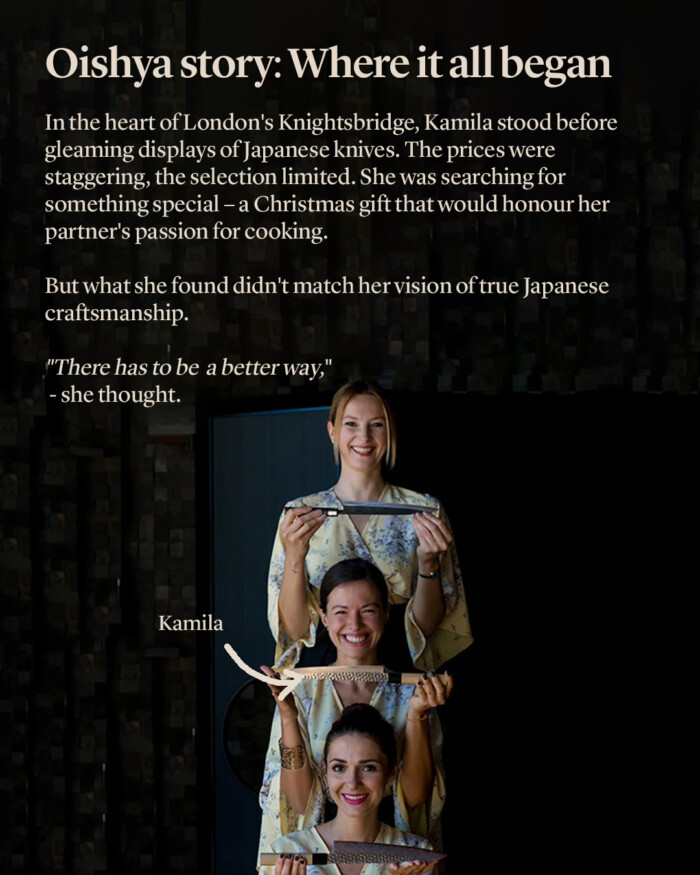
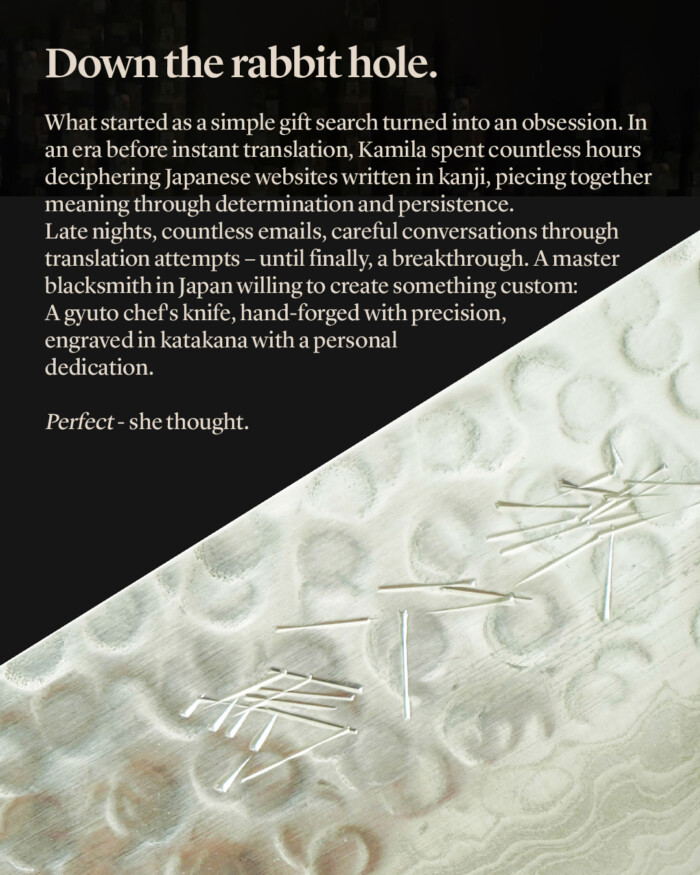
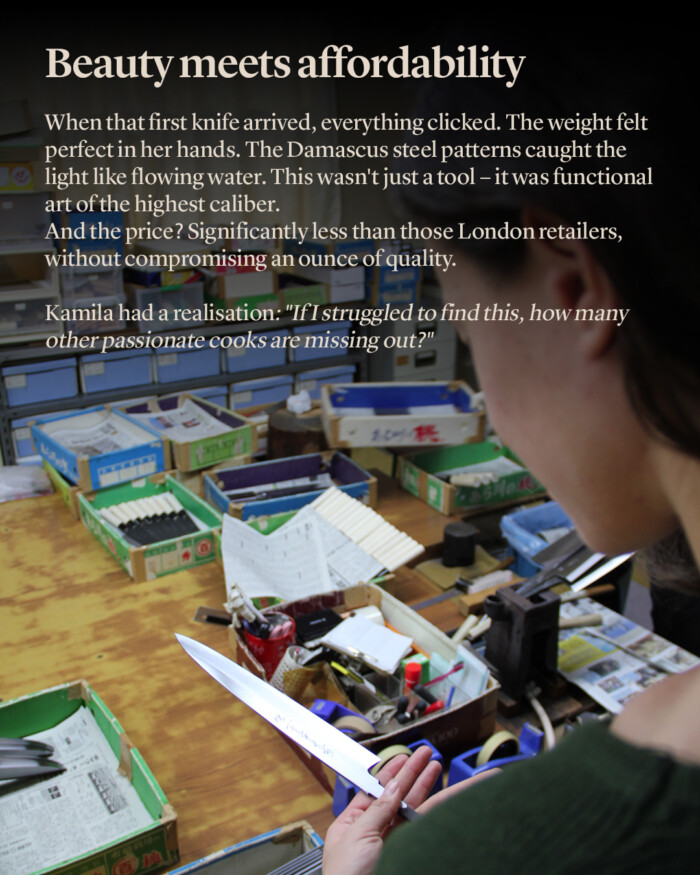

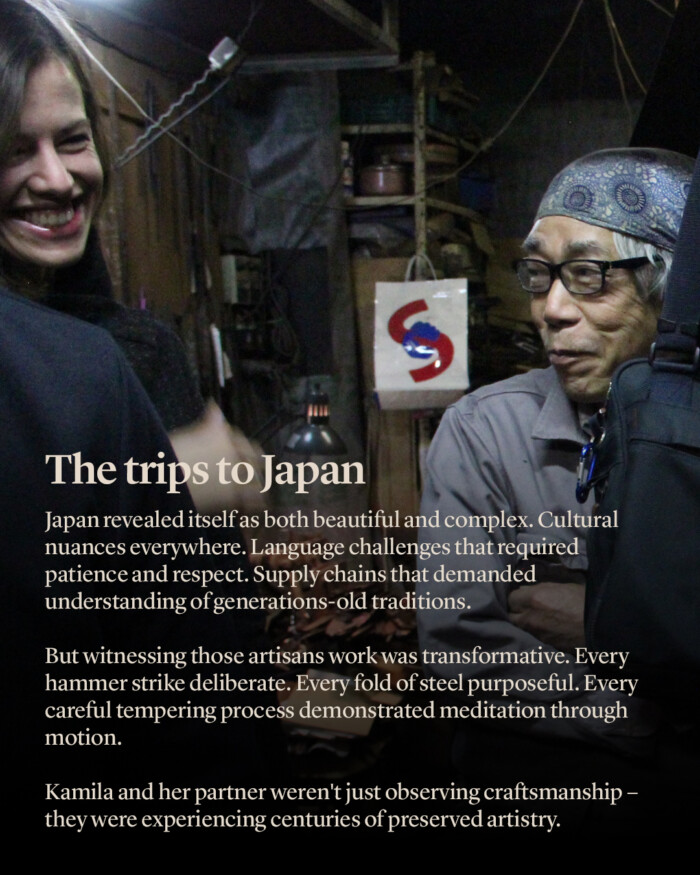
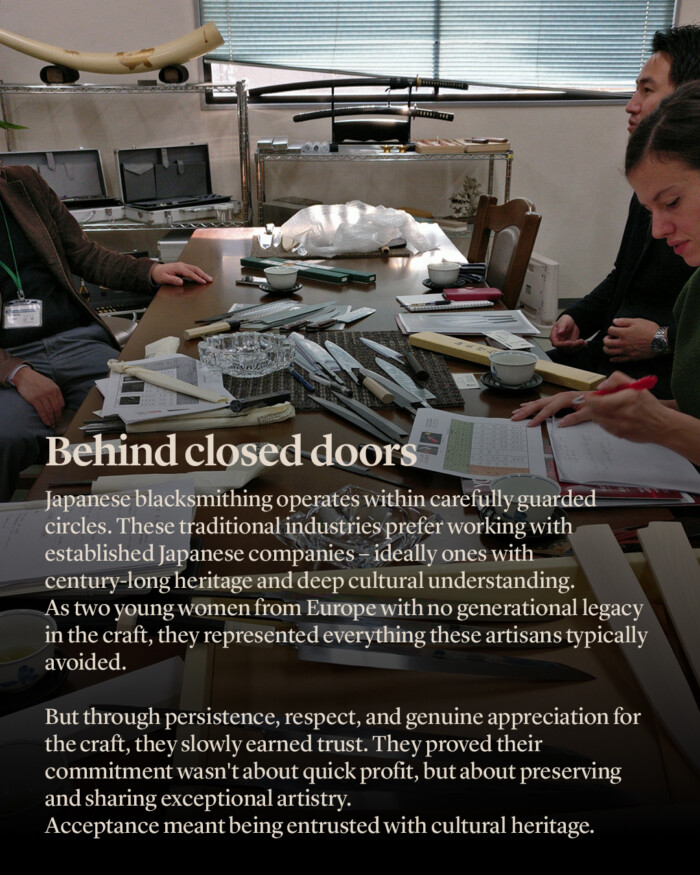
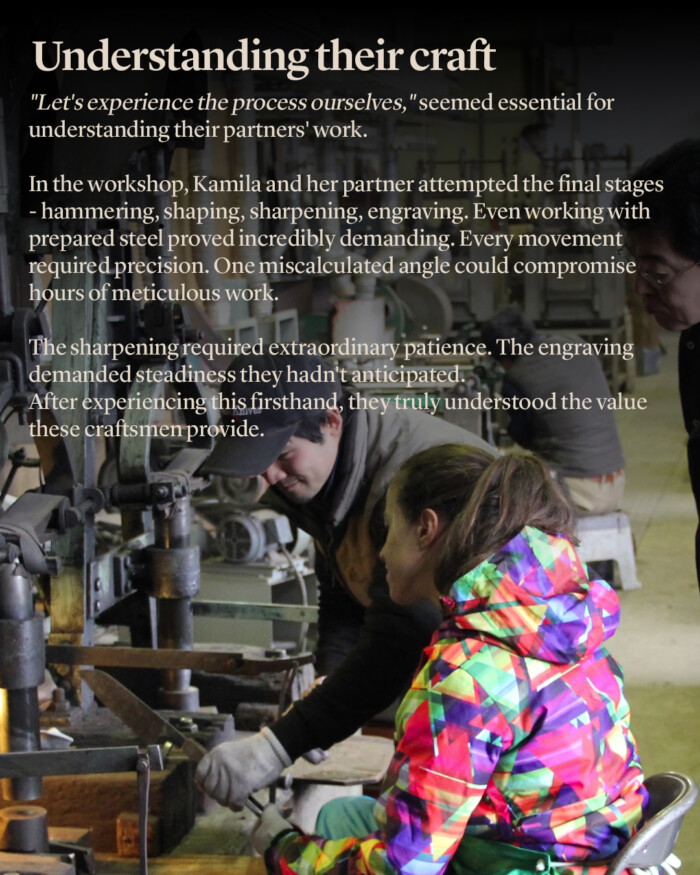
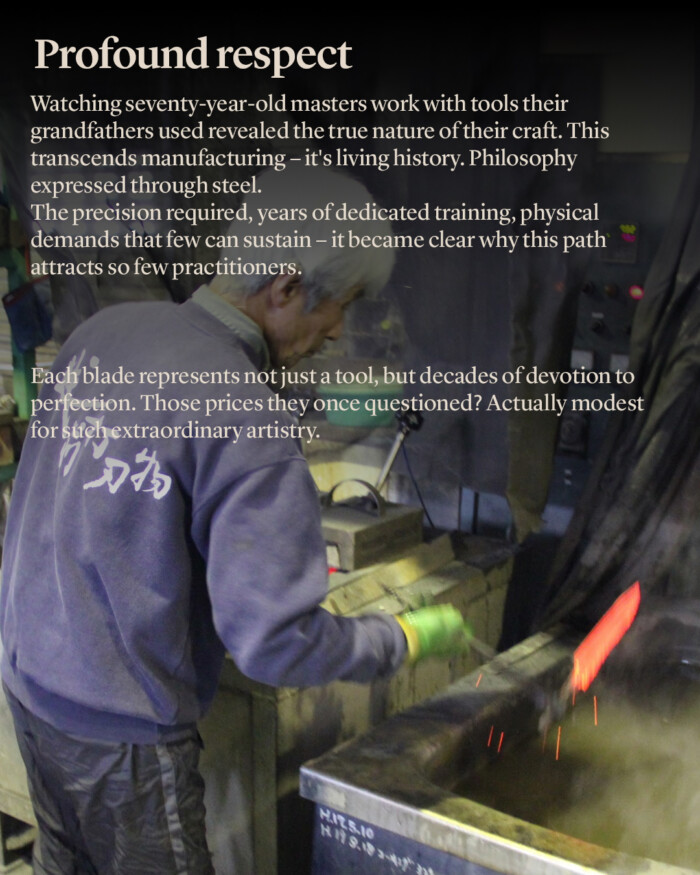




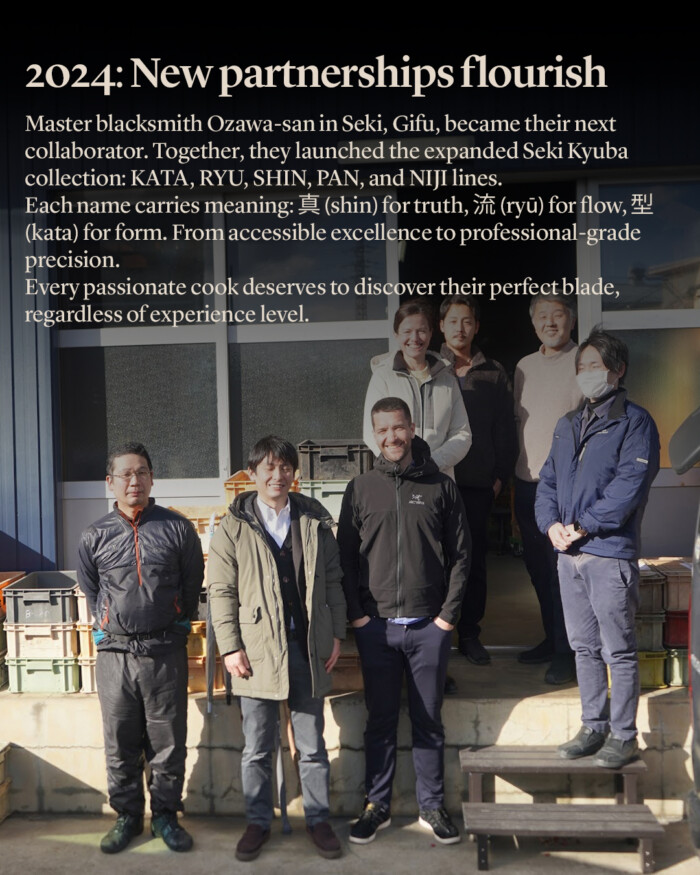
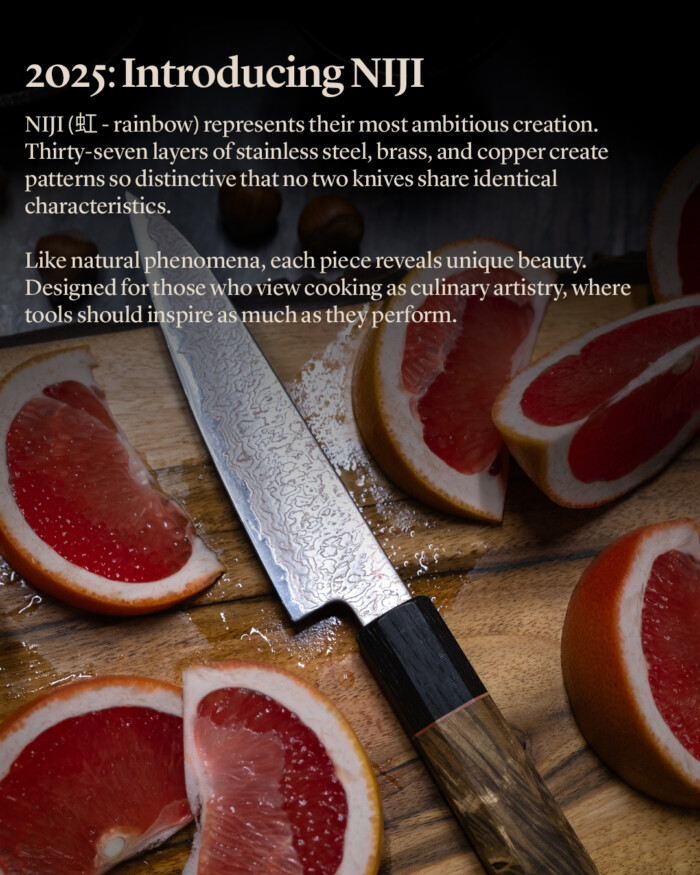


Our craftsmen and blacksmiths
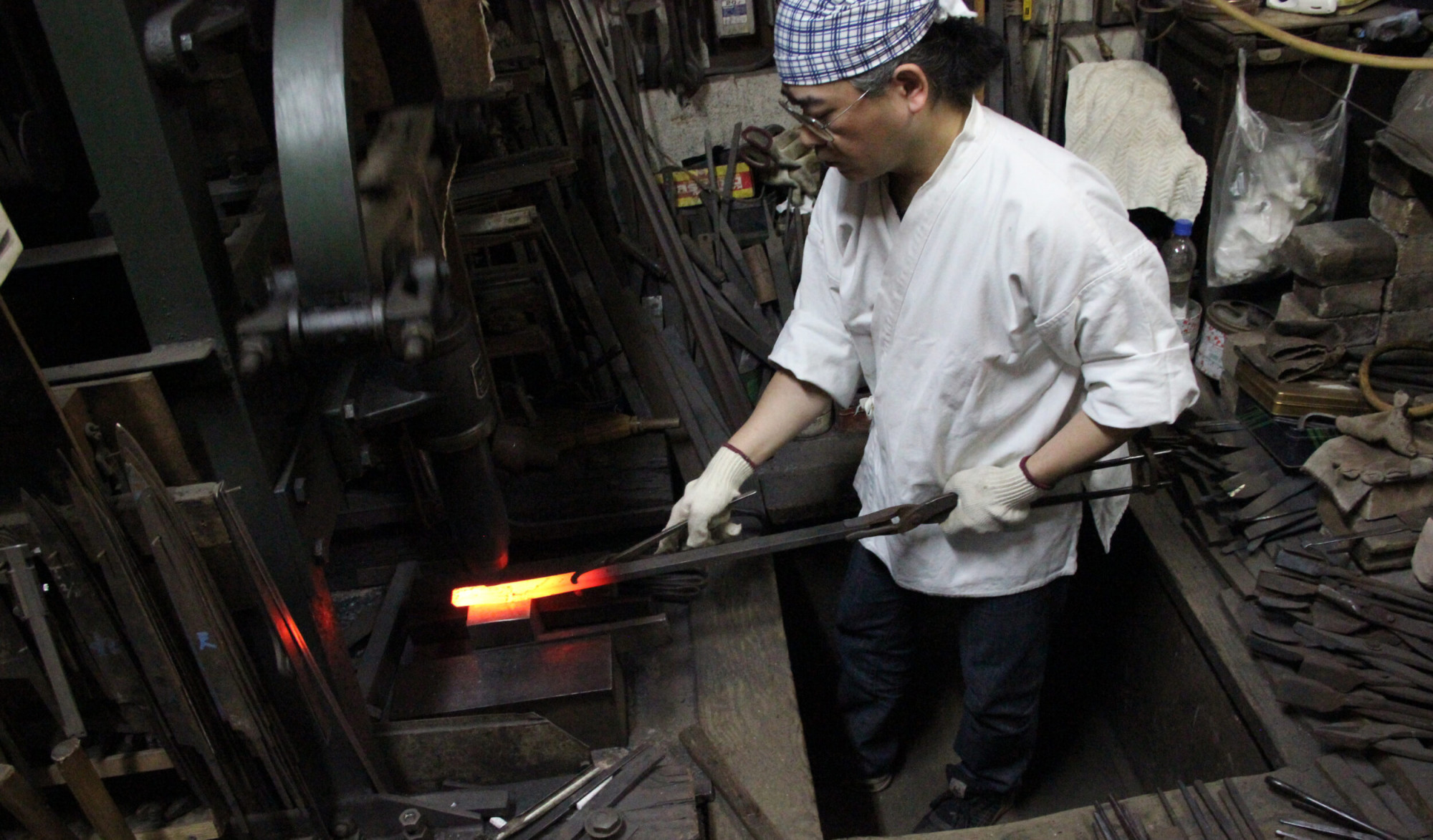
Sakai Kyuba 堺久馬 is the name of our line of Japanese kitchen knives. Under the Sakai Kyuba brand lies the artistry of one of the most famous blade masters in Sakai (Osaka Prefecture), Japan, drawing from over 600 years old blacksmithing tradition.
Although inspired by over 600 years of tradition, nothing about Sakai Kyuba is left to chance. Every single blade has been meticulously handmade and perfected in Japan by Sakai’s (堺市) master blacksmith. Each blade is then forged and hand-polished in Japan by master swordsmen using techniques perfected by their families over centuries. The handle and blade are satin-finished to a subtle, yet stunning lustre. Made from the highest quality AUS10 46-layer Damascus Hammered Stainless steel – sturdier and sharper than anything you have experienced before. Crafted, not manufactured. No handle pattern is the same, guaranteeing you a unique piece of craftsmanship.
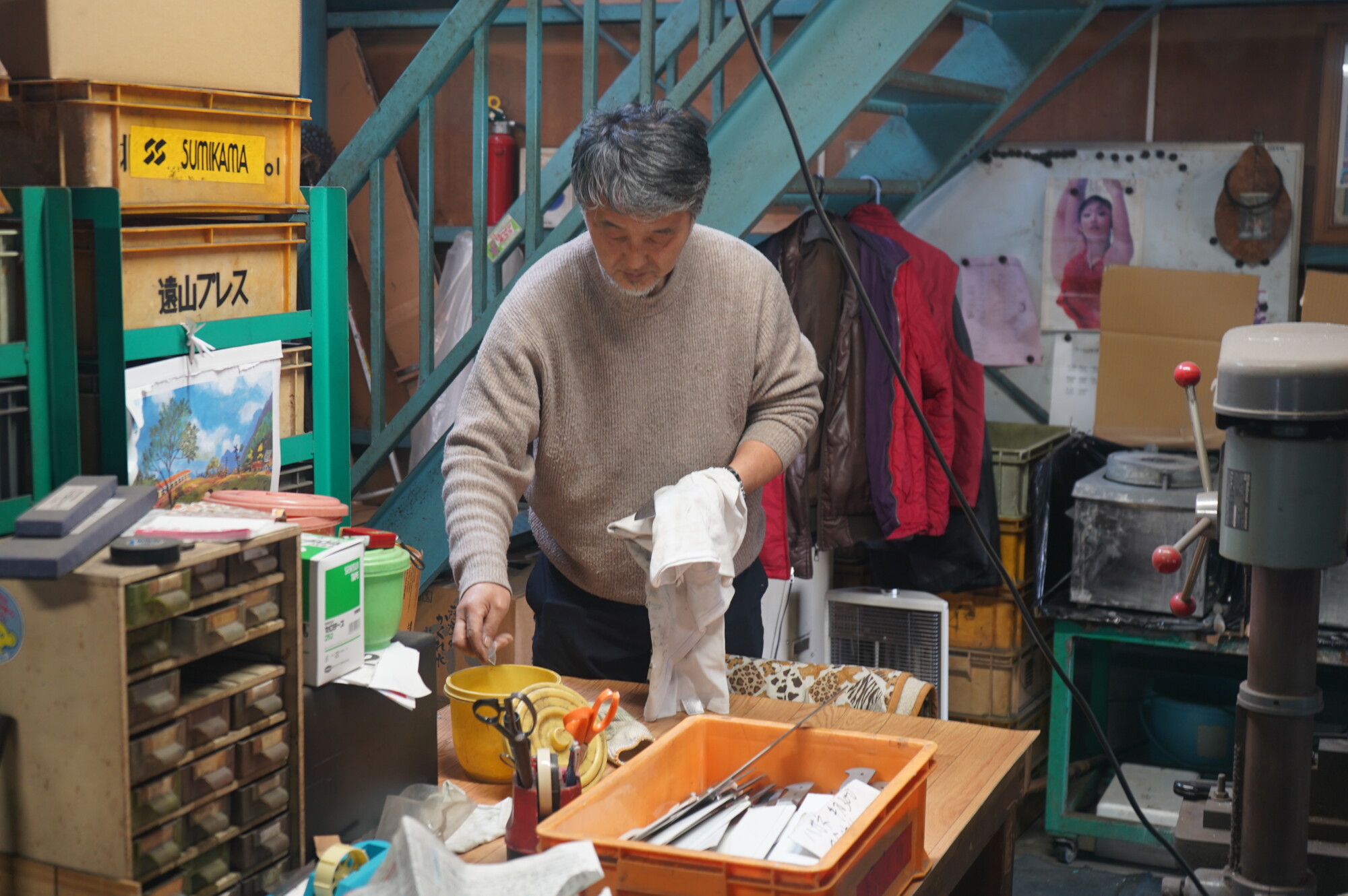
The story of our Seki Kyuba (席 急場) knives begins in the historic city of Seki, Gifu prefecture, where Japanese blade-making traditions date back to the 12th century. After years of searching, we found an extraordinary master blacksmith who has been perfecting his craft since 1975. His philosophy beautifully aligns with ours – honouring centuries-old traditions while embracing innovative techniques to create truly exceptional knives.
Whilst we cannot share his name due to regional exclusivity agreements, his artistry speaks through every blade he crafts. Known throughout Japan for creating knives for everyone from passionate home cooks to world-renowned chefs, he brings decades of expertise to each piece. To make each knife even more special, we collaborate with skilled European artisans who craft our distinctive colourful maple burl handles, creating a unique fusion of Japanese and European craftsmanship.